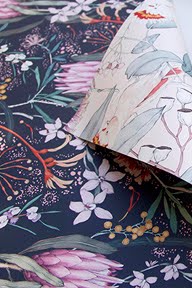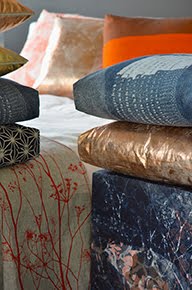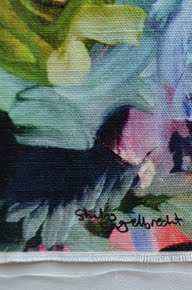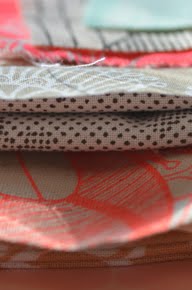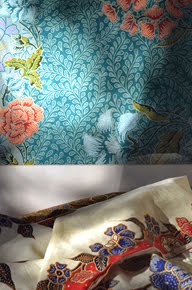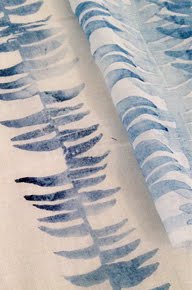The textile realm is rich with people who get things done. They
are among the makers of our world: those who use their hands, hearts and bodies
to carve creative vocations. Often, instead of planning and plotting, they just
do. Sleeves rolled up, they dive into their dreams, learning and growing along
the way. In this spirit, three enthusiastic young women created Ink and Spindle
just over 8 years ago. Their collective determination poured into everything
from stripping floors to a self-made printing table. And in this same spirit, one
of Australia’s friendliest textile studios opens its doors to interns, an eclectic
mix of textile lovers who eagerly arrive to also learn by doing.
A few months ago, it was me who donned a studio apron.
Having long recognized the gap between tertiary textile training, hands on workshops
and the realities of running a small business, I was hungry to learn more about
the day-to-day workings of a textile label. My first visit to Younghusband Studios
in Melbourne’s Kensington, where Ink and Spindle is based, was two years ago. Inspired
by the open and honest approach adopted by its creators, I knew the tutelage of
Lara Cameron and Caitlin Klooger (who joined the business in 2014) would help
me to refine my own dreams.
Each textile studio mirrors the character of its creators. Aspirations,
personality and skill influence decisions and direction. Over time, like any
small business, day-to-day activities reflect these choices, shaping the look,
feel and activity in each workspace. For Ink and Spindle, who elected from the
outset to hand screen print its own yardage to order, this means lots of
printing.
So a 10 metre metal table dominates the studio space, flooded with light by three large industrial arched windows rimmed in their famous ‘Duck Blue’. A working cloth protects the table when idle, peeled back from the slightly padded and adhesive table surface when it is time to print. Being almost two metres wide, Lara and Caitlin work in unison across the table’s width. Together they roll out fresh yards of natural, organic cloth, using the adjustable stops set in the rail along the table’s edge to place the screen in the correct spot each time. After first flooding the silk screen with a colour of their client’s choice, they pass the ink from one to the other three times using a squeegee, the rhythm and intimacy of the process mesmerising to watch.
 |
| Printing in tandem on the 10 metre table. |
So a 10 metre metal table dominates the studio space, flooded with light by three large industrial arched windows rimmed in their famous ‘Duck Blue’. A working cloth protects the table when idle, peeled back from the slightly padded and adhesive table surface when it is time to print. Being almost two metres wide, Lara and Caitlin work in unison across the table’s width. Together they roll out fresh yards of natural, organic cloth, using the adjustable stops set in the rail along the table’s edge to place the screen in the correct spot each time. After first flooding the silk screen with a colour of their client’s choice, they pass the ink from one to the other three times using a squeegee, the rhythm and intimacy of the process mesmerising to watch.
It is these folds of drying fabric framing the print time chatter and lively tea breaks that give Ink and Spindle its fond feel. Bolts of finished fabric, paint stands, cutting tables and the studio of Abby Seymour Jewellery and Handmaker’s Factory group around the central space, with couriers, customers, neighbours and friends maintaining an almost constant procession of contact and fun. The relaxed and easy greeting extended to each reveals the genuine heart of this business, and goes a long way to explaining why this internship process works so well for both the brand and those who come to learn.
 |
| Studio screens and the cleaning trough, where a high pressure hose is used to remove the water soluble ink from the screen before it dries. |
“Firstly we just love having new faces around,” explains
Lara, “getting to know everyone, their passions & ideas - it can be quite
inspiring! Secondly it's definitely invaluable having an extra pair of hands
around, especially on the two days a week we spend solidly printing,” she says.
During these days, interns are involved in preparing and
washing screens, packing orders, mixing ink and a range of incidental learning
based on whatever is happening in the business at the time that, lucky for me,
included a photo shoot and meetings with collaborative partners. Lara believes
in these practical learnings, explaining that “there are so many practical
aspects involved in what we do that you could never really learn without seeing
a fully functioning business in operation. It's one thing to learn an ‘art
practice’ during a course, but another thing entirely to transform that
practice into something that's efficient enough to be sustainable in a business
sense (and environmentally too, preferably)!”
“For example,” she continues, “we tend to limit the number
of screens used in a design, sometimes using the same screen offset or rotated
for the second colour, mainly because it's more cost efficient. We also
demonstrate simple things like resting your spatula on the lid of your ink tub
instead of inside it, so that ink doesn't get onto the handle - and then on
your hands - from the rim of the tub. Sounds petty but it prevents a lot of
mess!”
It is precisely these practical tips that filled my cup during my two weeks at Younghusband. It is almost impossible to convey the weighty benefit of such advice in a how-to publication, formal design training or short course. These are the types of skills best learnt on the job, and repeated daily, that ultimately make an enormous difference in the efficiency and ultimate profitability of each making business.
 |
| A small break between printing panels to prevent the ink moving to unwanted spots. |
It is precisely these practical tips that filled my cup during my two weeks at Younghusband. It is almost impossible to convey the weighty benefit of such advice in a how-to publication, formal design training or short course. These are the types of skills best learnt on the job, and repeated daily, that ultimately make an enormous difference in the efficiency and ultimate profitability of each making business.
“Efficiency, streamlined processes and correct pricing are
hugely important with any creative practice,” adds Lara, “to prevent burnout
and pursuing ideas or products that aren't going to be viable to produce in the
long run. We see far too many tea-towels, garments, cushions, zip pouches etc that
are massively underpriced, and often you see those labels disappear within a
year.”
When talking about how internships can fit into other craft
businesses, Lara says, “I think running an internship program doesn't suit all
businesses, and it certainly wasn't something we felt ready for until we were
well established and felt we had enough tasks and advice to impart to make the
internship worthwhile. We tend not to take anyone on for too long, partly
because we have a lot of demand for the position and partly because we don't
want to be taking advantage of anyone's labour once we've imparted as much
knowledge as we practically can. If in doubt, it can work well to have someone
in just one or two days a week over a longer period, so you can make those days
interesting.”
Her answer reflects the genuine heart that beats through
this business. Knowing that I was visiting other textile businesses could have
potentially rattled Caitlin and Lara. Theirs is after all, a competitive
business, closely related to cut throat world of fashion. But it didn’t – their
good will, openness and genuine desire to see Australian textile makers thrive
allowed them to offer me the same experience as the community of friends and
creatives they have created. Bending and flexing with the changing needs of the
market, and their own life cycles, this business is as much about people as it
is all of that printing. People and printing – that’s not bad!
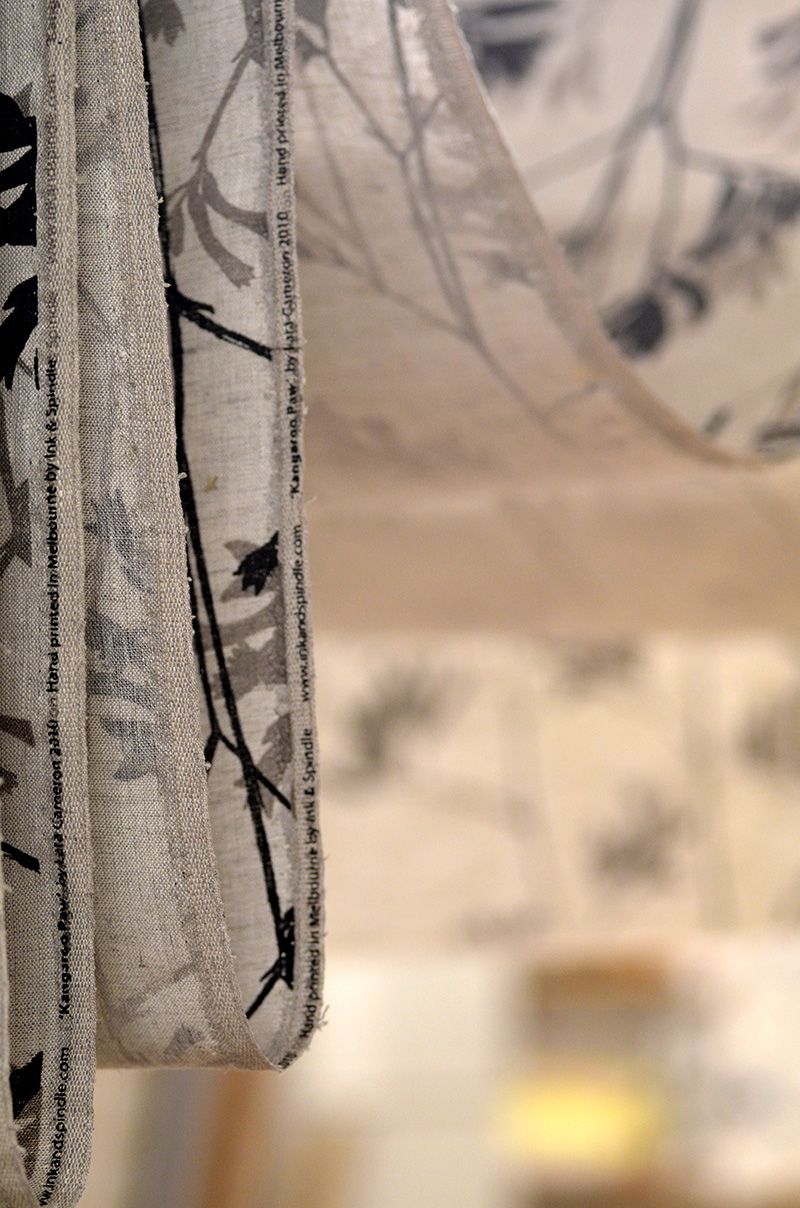 |
| A two colour print of Kangaroo Paw dries in the studio. |
Ink and Spindle puts out a call for interns twice a year. Be sure to keep an eye on their social media, or check the relevant section of their website, if this is of interest to you. You can also read another article I wrote about them here.
Jodie x


